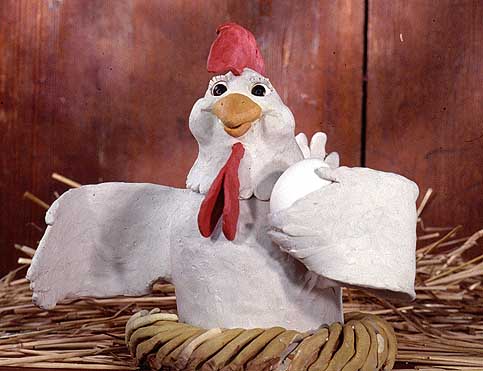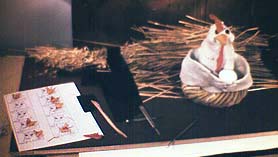
As I mention on the "Ball Joints" page, this chicken character has an armature of thick aluminum foil in the wings, soft iron wire in the comb on top of the head and in the wattle under the beak. This makes it easy to animate, and the different parts hold their form well after any adjustment. This is important, since all the parts of a figure should stay just where you move them, and not spring back.

Here you can see the entire setup I used for the shooting of the clay animation: The lighting consists of three 800 Watt halogen "redheads" plus a few assorted spots and smaller lamps, assorted reflectors and shadow boards. There is a shadow cast on the background by a cut mask in front of one of the redheads.
The camera is a 35 mm Arriflex that I built a stop-motion motor for. Just to the right of the Arri you can see a video camera. It is connected to the Macintosh you see to the right. With the aid of the ANIMAC Pencil Test Program I was able to record the animation simultaneously into the computer and onto 35 mm film. This enabled me to check the work in progress, in perfect sync with the soundtrack! Once, when the wing of the chicken broke off (which normally would be a disaster), I could reposition it with the help of the ANIMAC, and absolutely nothing of the "disaster" shows in the final film.

The eyes of the chicken are painted wooden beads. The small holes in the pupils enabled me to turn the eyes with a small pin. When the chicken blinked, I animated the eyelids by remodelling the clay frame by frame. To do the lipsync, I had recorded the soundtrack into the ANIMAC program, and made a hand-drawn rough animation of the talking beak. This enabled me to check the sync and the beak positions before I even started to animate the clay figure.
Using this hand-drawn animation as a guide, I made several different, removable clay beaks. They were attached to long nails which could be pushed into the chick's head. In this way I didn't have to model the beak anew for every frame. In the picture above, you see some of the beaks on a printout of the hand-animated frames. And since I had printed out the exposure sheet, I knew exactly in which frame each beak should appear! You can see the exposure sheet and the dialogue list below the computer in the picture of the setup. The ANIMAC system simplified and speeded up the job enormously. But still, many days and evenings passed until I had completed the three 20-second commercials...

Here I am, working on the animation, frame by frame. I did this work alone, only had help with the setup of the background and the lights.
You can see the final animation of one of the three commericals on the "Animation Samples" page.